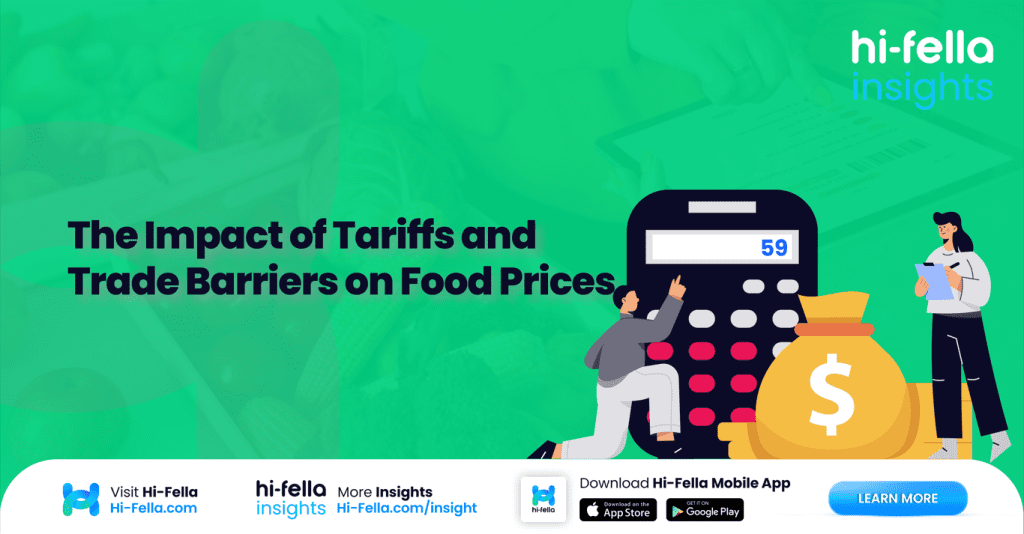Let’s be real—when we think of food prices going up, most people blame it on inflation, fuel costs, or weather. All fair. But lurking behind the labels and price tags of your favourite snacks, produce, or imported chocolate bar is something sneakier and a bit more… geopolitical: tariffs and trade barriers.
In this article, we’re cracking open the black box of international trade to reveal how government policies can mess with your grocery bill. We’ll explore the different types of trade barriers, how they ripple across the supply chain, and what they mean for food businesses and consumers alike.
So grab a coffee, maybe a snack (if it’s not too expensive), and let’s get into it.
First, What Are Tariffs and Trade Barriers?
Before we start ranting about rising food prices, let’s define our villains:
- Tariffs are taxes imposed on imports (and sometimes exports). So, when a country brings in foreign goods, they slap on a tax—kind of like a toll fee for crossing borders.
- Trade barriers are any rules, quotas, or regulations that make it harder (or more expensive) to trade across borders. Think: import bans, quotas, lengthy inspections, labelling requirements, and subsidies for domestic farmers that make imported goods less competitive.
These tools are often used to protect local industries or retaliate against unfair trade practices. Sounds noble, right? But the side effects—especially for food—can be pretty intense.
How Tariffs Affect Food Prices
Tariff Shock 101: The Domino Effect—Explained
Tariffs don’t exist in a vacuum. When one country decides to impose a tariff—especially on food or agricultural goods—it triggers a ripple effect that affects everyone along the supply chain, from importers and manufacturers to your local grocery store shelf.
Let’s revisit our original example, but this time, let’s flesh it out and walk through each step of the chain reaction.
🔄 Step 1: The Tariff Hits
Let’s say Country A is one of the world’s top wheat producers. It decides to place a 25% export tariff on wheat. Why? Maybe to:
- Protect its domestic food supply (national security vibes)
- Raise government revenue
- Force foreign companies to set up operations inside the country
- Respond to diplomatic tension (hello, trade war)
Now, Country B, which doesn’t grow enough wheat locally, suddenly has to pay 25% more just to get the same raw material.
✋ And here’s the key: wheat is not a final product—it’s a base ingredient. So, the pain doesn’t stop there.
🏭 Step 2: Local Manufacturers Feel the Squeeze
Country B has pasta factories that rely heavily on wheat to produce spaghetti, lasagna sheets, and instant noodles.
That 25% increase on imported wheat isn’t something they can easily absorb. Margins in food manufacturing are already tight. So what do they do?
- Try to source wheat from other countries, possibly at higher logistics costs or lower quality.
- Raise their product prices to cover the increased input costs.
- Cut corners—cheaper ingredients, smaller portions, or fewer promotions.
Some smaller factories may even pause operations, especially if their competitors abroad aren’t dealing with the same tariff situation.
🛒 Step 3: Retail Prices Rise
Now those higher production costs get passed to distributors, supermarkets, and retailers.
By the time that packet of spaghetti lands on a store shelf in Country B, it might cost 30% more than it did before the tariff was introduced.
The math? 25% increase on wheat ➡️ 10% markup from manufacturer ➡️ 5% distribution cost hike ➡️ 5% retailer margin = Hello, inflated grocery bill.
Consumers, understandably, are not thrilled. They start:
- Buying less
- Switching to cheaper local brands
- Substituting pasta with rice or bread
- Complaining on social media (because of course)
Real-World Parallel: The 2022 India Wheat Export Ban
After a heatwave slashed its wheat output, India imposed a ban on wheat exports in 2022 to protect domestic food security. This wasn’t technically a tariff, but the effect was similar—sudden restriction of supply in global markets.
- Wheat prices globally surged.
- Countries in the Middle East, Africa, and Southeast Asia that relied on Indian wheat scrambled for alternatives.
- Food processors had to raise prices on everything from bread to noodles to snacks.
This shows how any restriction on trade—whether a tax or a ban—has cascading effects, especially for global food systems that are more interdependent than ever.
It’s Not Always Instant—But It’s Inevitable
Some people think food prices adjust overnight. Not true. Sometimes:
- Manufacturers have reserves of ingredients that delay the impact.
- Distributors lock in prices with long-term contracts.
- Governments subsidise food temporarily to keep prices stable.
But once those buffers wear off? Prices catch up. Always.
Tariffs Can Also Affect Imported Finished Goods
This isn’t just about ingredients. Sometimes the tariffs apply directly to final, ready-to-eat foods:
- Imported cheese
- Canned tomatoes
- Breakfast cereals
- Wine or coffee
If your country imposes (or faces) a tariff on those items, you’ll feel it in your wallet—maybe not today, but soon. And don’t be surprised if “limited stock” signs start popping up on imported goodies.
How the Dominoes Fall
Here’s the flow in a nutshell:
Tariff on raw ingredient → Higher import costs → Higher manufacturing costs → Higher wholesale prices → Retail price increase → Consumer complaints, reduced demand, or brand switching
That’s the anatomy of tariff shock. It’s not just about macroeconomics—it’s about your weekly grocery run and the noodles in your pantry.
Case Study: US-China Trade War and Soybeans
In the 2018–2019 trade tensions between the US and China, China imposed heavy tariffs on US soybeans. The result?
- US soybean exports to China plummeted.
- US farmers lost a key market and had surplus crops.
- Prices dropped locally in the US due to oversupply, while prices spiked in countries like China as they scrambled for alternative sources.
- Countries like Brazil stepped in, becoming the new soybean supplier to China—and prices fluctuated globally.
This is a perfect example of how a single tariff on a key commodity can create ripple effects across several countries and industries.
Non-Tariff Barriers: The Subtle Price Hike You Didn’t See Coming
Not all trade restrictions come with a clear price tag. Non-tariff barriers (NTBs) include things like:
- Complex customs procedures
- Health and safety certifications
- Restrictions on genetically modified food
- Labelling and packaging requirements
While they might be framed as “consumer protection,” these barriers can delay shipments, limit supplier choices, and increase compliance costs. For food businesses, this translates to longer lead times, more bureaucracy, and—yep—higher costs.
When Domestic Subsidies Become a Global Problem
Let’s throw a curveball here: Sometimes it’s not about blocking imports but propping up domestic production with subsidies. Countries like the US and EU have long histories of subsidising their farmers to protect local agriculture.
Here’s the catch:
- Local farmers thrive.
- They export their surplus food at lower prices.
- Farmers in developing countries can’t compete with these artificially low prices.
- Long-term? It stifles local agriculture elsewhere and causes price instability in global markets.
You see? The system’s more interconnected than it looks. It’s like a global food Jenga tower—pull the wrong piece, and everything shifts.
Impact on Developing Countries
For developing nations that rely heavily on imported food, tariffs and trade barriers can be brutal. A country with minimal local food production may depend on rice, wheat, or milk from abroad.
- If global suppliers are hit with tariffs or restrictions, food prices spike.
- That leads to inflation, food insecurity, and even social unrest (remember the 2007–08 global food crisis?).
- In extreme cases, trade barriers can literally mean the difference between a stable food supply and a crisis.
So, What Can Businesses and Consumers Do?
📦 For Food Businesses:
- Diversify sourcing: Don’t rely on a single country or supplier. Spread your supply chain risk.
- Keep up with trade news: Political decisions can shift prices overnight. Stay informed and agile.
- Pass costs creatively: Instead of raising sticker prices, consider smaller portion sizes, bundling, or loyalty programmes to maintain value perception.
🧾 For Consumers:
- Support local: When global food gets expensive, local products can become more attractive—not just for price, but also for sustainability.
- Understand the bigger picture: When your favourite imported cereal gets pricier, it’s not always the brand’s fault. There might be a geopolitical soap opera behind it.
Looking Ahead: Can Trade Barriers Be a Good Thing?
Surprisingly—yes. Not all trade barriers are bad. In fact, some:
- Encourage local food production and food sovereignty.
- Help enforce safety standards (e.g., banning contaminated imports).
- Protect small-scale farmers in developing countries from being crushed by global giants.
It all depends on how the tools are used. Like a sharp knife in the kitchen—trade policy can help or hurt, depending on who’s wielding it and what they’re cooking up.
Ready to Navigate This Complex Landscape? Hi-Fella Can Help
For food businesses juggling shifting tariffs, sourcing headaches, and rising costs, Hi-Fella is your go-to platform. Hi-Fella connects verified suppliers and buyers in a global digital marketplace.
Whether you’re looking to source smarter, market globally, or simply stay ahead of the curve, Hi-Fella is where the next generation of food businesses thrive—trade wars or not.








